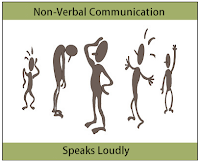"How can parents teach nonverbal communication and body language to a child who can read neither?"
Most children communicate naturally and instinctively. However, communication is a highly complex process that requires the spontaneous organization of several different functions. For example:
Most children communicate naturally and instinctively. However, communication is a highly complex process that requires the spontaneous organization of several different functions. For example:
- Emotional controls: to be comfortable socially requires that a child learns how to control his emotions and use them in a way appropriate to the circumstance
- Listening skills: for a child to understand what she is hearing requires that what she hears is automatically turned into understood thoughts
- Reading body language: reading body language accurately requires that the child learns the meaning of non-verbal cues (e.g. smiling, frowning, etc.)
- Verbal communication: to speak naturally requires that the cerebellum has hard wired the process of turning thoughts into speech

With Asperger's (AS) and High-Functioning Autism (HFA), one or more of these skills are not fully developed, so children on the autism spectrum ‘overload’ their working memory and don’t take into account all of the various information required for natural social interaction.
Good communication is the foundation of any successful relationship – and nonverbal communication speaks the loudest (e.g., facial expressions, gestures, eye contact, posture, tone of voice, etc.). The ability to understand and use nonverbal communication is a powerful tool that can help children connect with others, express what they really mean, and build better relationships.
Since nonverbal communication does not come naturally to AS and HFA children, it must be taught. Below is some vital information that parents (and teachers) can share with their “special needs” child to help him or her begin to develop the ability to read nonverbal cues. Change the wording as needed so your child will understand. And don’t be surprised if, at times, you child feels as though you are speaking a foreign language, because nonverbal communication is indeed foreign to AS and HFA kids. Pick one point at a time to discuss (perhaps one point a day over the course of 12 days), and try to give examples of each point that your child can relate to directly.
==> Teaching Social Skills and Emotion Management to Children and Teens with Asperger's and High-Functioning Autism
==> Teaching Social Skills and Emotion Management to Children and Teens with Asperger's and High-Functioning Autism
Point #1: Discuss body movements and posture. Consider how our perceptions of people are affected by the way they hold their head, sit, walk, or stand up. The way we move and carry ourselves communicates a wealth of information to others. This type of nonverbal communication includes stance, posture, bearing, and subtle movements.
Point #2: Discuss eye contact. Since the visual sense is dominant for many people, eye contact is an especially important type of nonverbal communication. The way we look at someone can communicate many things (e.g., attraction, interest, affection, hostility, etc.). Eye contact is also important in maintaining the flow of conversation and for evaluating the other person’s response.
Point #3: Discuss facial expressions. The human face is extremely expressive and able to convey numerous emotions without saying a word. And unlike some forms of nonverbal communication, facial expressions are universal. The facial expressions for anger, fear, happiness, sadness, surprise, and disgust are the same across cultures.
Point #4: Discuss gestures. Gestures include waving, pointing, using your hands when you are arguing or speaking animatedly. We often use gestures without thinking about it.
Point #5: Discuss space. Has anyone ever told you that they felt uncomfortable during a conversation because you were standing too close and invading their space? Everyone has a need for physical space, although that need differs depending on the person, the situation, and the closeness of the relationship. We can use physical space to communicate many different nonverbal messages (e.g., signals of affection, aggression, submissiveness, dominance, etc.).
Point #6: Discuss touch. You communicate a great deal through touch. Think about the nonverbal messages given by the following acts: a controlling grip on your arm, a patronizing pat on the head, a reassuring pat on the back, a timid tap on the shoulder, a warm bear hug, or a weak handshake.
Point #7: Discuss voice. It’s not just what we say, it’s “how” we say it. When you speak, the other person “reads” your voice in addition to listening to your words. Things the other person may pay attention to include how loud you speak, sounds that convey understanding (e.g., ahh” and “uh-huh”), your timing and pace, and your tone and inflection. Think about how someone's tone of voice can indicate anger, sarcasm, affection, or confidence.
Point #8: Oftentimes, what comes out of your mouth and what you communicate through your body language are two totally different things. When faced with these mixed signals, the person that is listening to you has to choose whether to believe your verbal or nonverbal message. And in most cases, the other person is going to choose the nonverbal, because it's a natural, unconscious language that broadcasts your true feelings and intentions in any given moment.
Point #9: Pay attention to contradictions. Nonverbal communication should support what is being said. Is your friend saying one thing, but his body language saying something else (e.g., is he telling you “yes” while shaking his head no)? Don’t dismiss your gut feelings. If you get the sense that someone isn’t being honest, you may be picking up on a mismatch between verbal and nonverbal cues.
Point #10: The way we listen, move, look, and react tells the other person whether or not we care, if we are being truthful, and how well we are listening. When our nonverbal signals match up with the words we are saying, it increases trust and rapport. When our nonverbal signals don’t match up, it generates mistrust and confusion.
==> Teaching Social Skills and Emotion Management to Children and Teens with Asperger's and High-Functioning Autism
==> Teaching Social Skills and Emotion Management to Children and Teens with Asperger's and High-Functioning Autism
Point #11: When you interact with your friends and classmates, you continuously give and receive wordless signals. All of your nonverbal behaviors send strong messages (e.g., how close you stand to someone, how fast or how loud you talk, how much eye contact you make, the gestures you make, the way you sit, etc.). These messages don't stop when we stop speaking either. Even when we are silent, we are still communicating nonverbally.
Point #12: Lastly, along with your child, watch and discuss the video below on “reading facial cues”:
As your AS or HFA child continues to pay attention to the nonverbal cues he sends and receives, his ability to communicate will improve. By using the points listed above, parents can help their child gain the skills needed to communicate nonverbally, which is often the most important component of communication.
More resources for parents of children and teens with High-Functioning Autism and Asperger's:
==> How To Prevent Meltdowns and Tantrums In Children With High-Functioning Autism and Asperger's
==> Parenting System that Significantly Reduces Defiant Behavior in Teens with Aspergers and High-Functioning Autism
==> Launching Adult Children with Asperger's and High-Functioning Autism: Guide for Parents Who Want to Promote Self-Reliance
==> Parenting Children and Teens with High-Functioning Autism: Comprehensive Handbook


.jpg)


